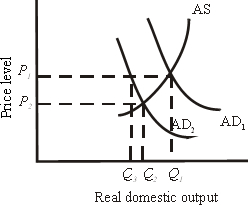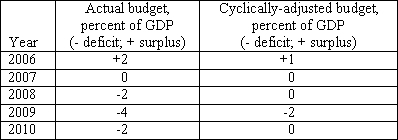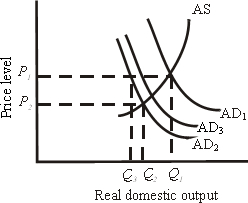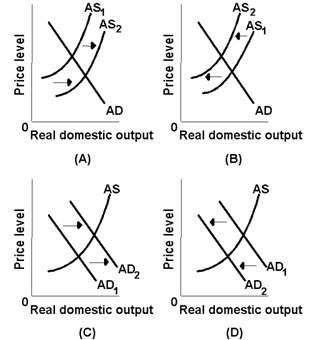 |
| 1 |  | 
Answer the next question using the following graph:
 <a onClick="window.open('/olcweb/cgi/pluginpop.cgi?it=jpg::::/sites/dl/free/0077337727/883758/ch30_q1.jpg','popWin', 'width=NaN,height=NaN,resizable,scrollbars');" href="#"><img valign="absmiddle" height="16" width="16" border="0" src="/olcweb/styles/shared/linkicons/image.gif"> (20.0K)</a> <a onClick="window.open('/olcweb/cgi/pluginpop.cgi?it=jpg::::/sites/dl/free/0077337727/883758/ch30_q1.jpg','popWin', 'width=NaN,height=NaN,resizable,scrollbars');" href="#"><img valign="absmiddle" height="16" width="16" border="0" src="/olcweb/styles/shared/linkicons/image.gif"> (20.0K)</a>
Refer to the graph. Suppose the full-employment level of GDP is Q1, but a significant decline in investment demand has pushed the economy into recession as shown by the decline in aggregate demand to AD2. Currently, output is at Q3 and there is a negative GDP gap (Q3 – Q1) of $100 billion. If the multiplier is 5, which of the following would most likely move the economy back to its full potential? |
|  | A) | A tax cut of $20 billion |
|  | B) | Increased government spending of $20 billion |
|  | C) | A tax cut of $100 billion |
|  | D) | Increased government spending of $100 billion |
|
|
 |
| 2 |  | 
Use the following table of hypothetical budget data to answer the next question:
 <a onClick="window.open('/olcweb/cgi/pluginpop.cgi?it=jpg::::/sites/dl/free/0077337727/883758/ch30_q2.jpg','popWin', 'width=NaN,height=NaN,resizable,scrollbars');" href="#"><img valign="absmiddle" height="16" width="16" border="0" src="/olcweb/styles/shared/linkicons/image.gif"> (24.0K)</a> <a onClick="window.open('/olcweb/cgi/pluginpop.cgi?it=jpg::::/sites/dl/free/0077337727/883758/ch30_q2.jpg','popWin', 'width=NaN,height=NaN,resizable,scrollbars');" href="#"><img valign="absmiddle" height="16" width="16" border="0" src="/olcweb/styles/shared/linkicons/image.gif"> (24.0K)</a>
Refer to the table. The changes in the budget conditions between 2008 and 2009 best reflect: |
|  | A) | demand-pull inflation. |
|  | B) | a cut in government spending. |
|  | C) | a tax increase. |
|  | D) | an expansionary fiscal policy. |
|
|
 |
| 3 |  | 
Of the following groups, the largest proportion of the total public debt is held by: |
|  | A) | foreign individuals and institutions. |
|  | B) | U.S. government agencies, including the Federal Reserve. |
|  | C) | State and local governments. |
|  | D) | U.S. banks and other financial institutions. |
|
|
 |
| 4 |  | 
The effectiveness of an expansionary fiscal policy will be reduced if: |
|  | A) | increased government borrowing increases interest rates, causing a reduction in private investment. |
|  | B) | it is accompanied by a cut in Social Security taxes as well. |
|  | C) | the price level falls. |
|  | D) | stock prices rise. |
|
|
 |
| 5 |  | 
Suppose the full-employment level of GDP is $250 billion in a hypothetical economy. Currently, aggregate expenditures total $270 billion. Which of the following would be most in accord with appropriate fiscal policy? |
|  | A) | Lower tax rates on corporate income |
|  | B) | Reducing or limiting personal deductions and credits when figuring personal income taxes |
|  | C) | Expanded spending on new domestic security programs |
|  | D) | Decreases in interest rates |
|
|
 |
| 6 |  | 
Which of the following discretionary policies both restrains the growth of government and helps return the economy to full employment? |
|  | A) | A tax cut in a recession |
|  | B) | A tax increase during inflation |
|  | C) | An increase in government spending during a recession |
|  | D) | A decrease in government spending in a recession |
|
|
 |
| 7 |  | 
Answer the next question using the following graph:
 <a onClick="window.open('/olcweb/cgi/pluginpop.cgi?it=jpg::::/sites/dl/free/0077337727/883758/ch30_q7.jpg','popWin', 'width=NaN,height=NaN,resizable,scrollbars');" href="#"><img valign="absmiddle" height="16" width="16" border="0" src="/olcweb/styles/shared/linkicons/image.gif"> (22.0K)</a> <a onClick="window.open('/olcweb/cgi/pluginpop.cgi?it=jpg::::/sites/dl/free/0077337727/883758/ch30_q7.jpg','popWin', 'width=NaN,height=NaN,resizable,scrollbars');" href="#"><img valign="absmiddle" height="16" width="16" border="0" src="/olcweb/styles/shared/linkicons/image.gif"> (22.0K)</a>
Refer to the graph. If AD1 represents the current level of expenditures and Q2 is the full-employment level of GDP, the government should undertake: |
|  | A) | an expansionary fiscal policy that reduces aggregate demand to AD2. |
|  | B) | an expansionary fiscal policy that reduces aggregate demand to AD3. |
|  | C) | a contractionary fiscal policy that reduces aggregate demand to AD2. |
|  | D) | b. a contractionary fiscal policy that reduces aggregate demand to AD3. |
|
|
 |
| 8 |  | 
Built-in stabilizers: |
|  | A) | automatically increase the size of deficits when the economy experiences demand-pull inflation. |
|  | B) | avoid the problems associated with the administrative lag of discretionary fiscal policy. |
|  | C) | automatically produce a budget that is balanced over the business cycle. |
|  | D) | tend to offset the impact of discretionary fiscal policy. |
|
|
 |
| 9 |  | 
Answer the next question on the basis of the following diagram.
 <a onClick="window.open('/olcweb/cgi/pluginpop.cgi?it=jpg::::/sites/dl/free/0077337727/883758/ch30_q9.jpg','popWin', 'width=NaN,height=NaN,resizable,scrollbars');" href="#"><img valign="absmiddle" height="16" width="16" border="0" src="/olcweb/styles/shared/linkicons/image.gif"> (39.0K)</a> <a onClick="window.open('/olcweb/cgi/pluginpop.cgi?it=jpg::::/sites/dl/free/0077337727/883758/ch30_q9.jpg','popWin', 'width=NaN,height=NaN,resizable,scrollbars');" href="#"><img valign="absmiddle" height="16" width="16" border="0" src="/olcweb/styles/shared/linkicons/image.gif"> (39.0K)</a>
An expansionary fiscal policy is best represented by graph: |
|  | A) | A. |
|  | B) | B. |
|  | C) | C. |
|  | D) | D. |
|
|
 |
| 10 |  | 
Which of the following exemplifies the crowding-out effect? An increase in government spending: |
|  | A) | is financed by increasing the money supply, reducing interest rates and causing net exports to fall. |
|  | B) | is financed by borrowing, raising interest rates and causing private investment to fall. |
|  | C) | causes taxes to rise automatically, reducing consumption spending. |
|  | D) | causes the price level to rise, reducing net exports. |
|
|

